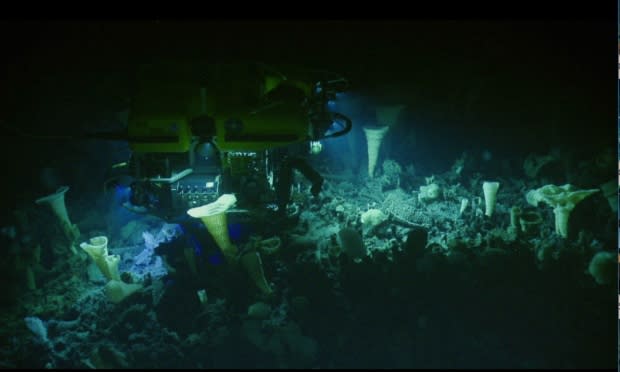Canada's biggest underwater volcano is just off B.C.'s coast — and scientists are finding new species there
Canada's largest underwater volcano is off the coast of British Columbia and, over the next two weeks, a team of national scientists will be doing a deep-sea exploration mission of the area.
The team from Fisheries and Oceans Canada set off Monday on the deep-ocean journey to research the Explorer Seamount — an underwater mountain west of Vancouver Island.
"The biodiversity and the abundance of life we see there is much like a tropical rainforest, except you just replace the birds with fish and the grizzly bears with a shark," said Cherisse Du Preez, a deep-sea marine ecologist.
"Then, you've got a picture of what it's like down there."
Du Preez spoke to CBC's On The Coast from the vessel, just before heading out.
At 2,000 square kilometres, the Explorer Seamount covers an area the size of greater Vancouver. It rises 2.5 kilometres above the surrounding sea floor, the same height Mount Baker rises above the ocean's surface.

Last year, the team did an initial four-hour dive of the seamount and discovered an incredible biodiversity hidden on the ocean bed, including new animal species.
"What we observed was completely unexpected," Du Preez said.
"There's a sponge garden, or sponge forest, down there … it's like an ancient, old growth forest that has just been lost in time."
This time, the team is sending down a submersible robot with flood lights, cameras and sensors. The equipment can be controlled from the ship and sends back real-time images, which are going to be broadcast live to the public.
"This part of the ocean has never seen the light of day before," Du Preez said.
"The robot captur[es] these animals just going about their natural day-to-day business."

She said factors like the geological, chemical, and ecological characteristics of the seamount are very different from other environments and could explain some of the never-before-seen biodiversity.
"There's a lot just fundamental curiosity and that's fantastic, it's like frontier science," said Du Preez.
The DFO scientists partnered with Ocean Networks Canada and the Nuu-chah-nulth Nation for the expedition.
For Du Preez, it's the opportunity of a lifetime.
"This is why we become scientists," she said.
"The fieldwork — it's all too brief but it keeps us going for years afterwards."
The first dive of the drop camera will take place on July 19 and can be watched online.


